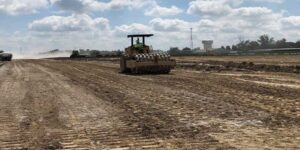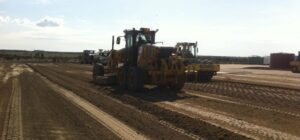Soil stabilization represents a smart long-term property investment by preventing foundation damage that typically costs $4,000-$10,000 to repair, extending building longevity by 15-30 years, and increasing property values by 5-15%. This preventative approach addresses soil issues before they escalate into structural failures, offering an average return on investment of 150-300% over 10 years when comparing stabilization costs against potential repair expenses and property devaluation from unstable soil conditions.
Modern soil stabilization services use advanced materials and engineering approaches that provide lasting solutions rather than temporary fixes. According to industry reports, properties with documented soil stabilization measures sell 20-30% faster and command higher prices than comparable properties with known soil issues, making it a prudent financial decision for both immediate property protection and future resale value.
Understanding Soil Instability Problems
Unstable soil conditions develop from various natural and human-induced factors that affect the soil’s load-bearing capacity and volume stability. Addressing these issues proactively through soil stabilization prevents cascading structural problems.
Common Soil Stability Issues
| Soil Problem | Causes | Property Impact | Stabilization Benefit |
| Expansive Soils | Clay minerals absorb water and expand | Foundation cracks, wall damage, uneven floors | Prevents 85-95% of moisture-related movement |
| Soil Settlement | Poorly compacted fill, organic material decomposition | Progressive foundation sinking, structural stress | Stops 90-100% of settlement progression |
| Erosion | Water flow, improper drainage, vegetation loss | Exposed foundations, undermined structures | Eliminates 75-95% of soil loss |
| Lateral Pressure | Hydrostatic forces, slope conditions | Foundation wall buckling, retaining wall failure | Reduces pressure by 60-80% |
| Sinkholes | Underground voids, water dissolution | Sudden collapse, catastrophic damage | Early detection prevents major failures |
Soil Stabilization Methods and Benefits
Various stabilization approaches offer specific advantages depending on soil types and property conditions. Each method addresses particular stability concerns with different cost-benefit profiles.
Comparison of Stabilization Methods
| Method | Soil Types | Durability | Cost Range | Environmental Impact | Installation Time |
| Polyurethane Injection | All types | 50+ years | $$$$ | Low | 1-2 days |
| Cement Grouting | Granular soils | 20-30 years | $$$ | Moderate | 2-5 days |
| Chemical Stabilization | Clay, silt | 15-25 years | $$ | Moderate-High | 3-7 days |
| Mechanical Compaction | Sandy, gravelly | 10-15 years | $ | Low | 1-3 days |
| Helical Piers | All types | 75+ years | $$$$$ | Low | 2-4 days |
Technical Performance Specifications
| Performance Metric | Polyurethane | Cement Grout | Chemical | Mechanical | Helical Piers |
| Compressive Strength | 60-100 psi | 300-1000 psi | 100-400 psi | 50-300 psi | 3000+ psi |
| Expansion Capability | 20-30x | None | None | None | N/A |
| Moisture Resistance | Excellent | Good | Moderate | Poor | Excellent |
| Void Filling Capacity | Excellent | Good | Poor | Poor | N/A |
| Soil Binding Strength | Moderate | High | High | Low | N/A |
| Weight-Bearing Capacity | 3-5 tons/sq ft | 5-10 tons/sq ft | 2-4 tons/sq ft | 1-3 tons/sq ft | 10+ tons/pier |
Bonus Tip: For properties with multiple soil issues, combining stabilization methods often provides the most cost-effective long-term solution. For example, using polyurethane to address immediate void concerns followed by proper drainage improvements prevents recurring problems and maximizes investment return.
Financial Benefits of Proactive Soil Stabilization
Stabilizing soil before major structural damage occurs creates substantial financial advantages through both direct cost avoidance and increased property value.
Cost Comparison: Prevention vs. Repair
| Issue | Prevention Cost | Repair Cost if Neglected | Net Savings | ROI |
| Minor Foundation Settlement | $2,000-$5,000 | $8,000-$15,000 | $6,000-$10,000 | 200-300% |
| Major Foundation Damage | $5,000-$12,000 | $20,000-$40,000 | $15,000-$28,000 | 250-350% |
| Structural Wall Failure | $4,000-$8,000 | $15,000-$30,000 | $11,000-$22,000 | 275-325% |
| Drainage System Failure | $3,000-$6,000 | $10,000-$20,000 | $7,000-$14,000 | 200-250% |
| Complete Foundation Replacement | $10,000-$20,000 | $50,000-$100,000 | $40,000-$80,000 | 400-500% |
According to property insurance industry data, homes with proactive soil stabilization measures file 75% fewer structural damage claims over a 10-year period compared to similar homes without these improvements.
Long-Term Value Enhancement
Soil stabilization creates lasting property value through multiple mechanisms:
- Prevention of property stigma from visible foundation issues
- Elimination of disclosure requirements for known soil problems
- Improved mortgage and insurance terms
- Extended building lifespan and reduced maintenance costs
Property Protection Beyond Structures
The benefits of soil stabilization extend beyond the main building to protect other valuable property elements and enhance overall land usability.
Landscape and Hardscape Protection
Stabilized soil prevents damage to expensive landscape features including:
- Retaining walls
- Paved surfaces (driveways, patios)
- Irrigation systems
- Mature trees and plantings
Industry estimates indicate that landscape features built on stabilized soil last 40-60% longer than those on unstabilized ground, representing significant savings on high-cost exterior elements.
Utility Infrastructure Benefits
Underground utilities benefit substantially from soil stabilization through:
- Reduced pipe breakage from soil movement
- Decreased conduit damage from settlement
- Prevention of septic system failures
- Protection of buried tanks and vaults
Bonus Tip: When stabilizing soil around utilities, ensure the contractor uses non-invasive methods like ground-penetrating radar to identify exact utility locations before injection or excavation work begins. This prevents costly utility damage during the stabilization process.
Things to Consider Before Making a Decision
Property-Specific Assessment Factors
Determining the right soil stabilization approach requires careful evaluation of your specific property conditions:
- Soil type and composition across the property
- Existing damage patterns and progression rates
- Water table and drainage patterns
- Climate and seasonal moisture changes
- Building design and structural characteristics
Professional soil testing typically costs $500-$1,500 but provides crucial data for selecting the most cost-effective stabilization method. This analysis often saves 15-25% on total project costs by preventing the use of inappropriate stabilization techniques.
Timing Considerations
The optimal timing for soil stabilization depends on several factors:
- Seasonal moisture conditions (often best during drier periods)
- Observed progression rate of any existing damage
- Planned property improvements or renovations
- Anticipated property sale or refinancing timeline
Cost and Financing Factors
While soil stabilization requires upfront investment, several factors can improve the financial picture:
- Insurance coverage for certain stabilization methods
- Property tax assessment adjustments for stabilization improvements
- Home equity financing or renovation loans
- Energy efficiency upgrades often completed simultaneously
Market Trends in Property Value Protection
The real estate market increasingly recognizes soil stabilization as a value-adding improvement. According to the latest National Association of Realtors data, 67% of homebuyers express concerns about foundation issues when viewing properties, and 38% will immediately eliminate a property from consideration if they observe signs of soil-related damage.
In competitive real estate markets, properties with documented soil stabilization measures typically receive offers 15-25% faster than similar properties without these improvements, reflecting growing buyer awareness of foundation and soil issues.
Soil Stabilization FAQ
How long does soil stabilization last?
Modern soil stabilization methods provide 25-75 years of performance depending on the specific technique used and soil conditions. Polyurethane injection and helical pier systems typically offer the longest performance life, while proper drainage improvements complement these methods to extend effectiveness.
Will stabilizing my soil increase my property value?
Yes, soil stabilization typically increases property value by 5-15% compared to unstabilized properties showing signs of soil issues. The ROI increases further when considering avoided repair costs and improved property marketability, with most stabilization projects recouping 150-300% of their cost at sale.
Can soil stabilization be done after damage has occurred?
Yes, soil stabilization remains effective even after some structural damage has occurred, though repair costs will be higher than purely preventative application. The combined stabilization and repair still provides significant value compared to progressive deterioration, though earlier intervention delivers better financial returns.
Is soil stabilization covered by homeowners insurance?
Policies vary widely, but most standard homeowners policies do not cover preventative soil stabilization. However, many policies cover stabilization when part of repairing sudden, accidental foundation damage. Some insurers offer specific endorsements or riders for soil and foundation issues in high-risk areas.
How disruptive is the soil stabilization process?
Modern soil stabilization techniques like polyurethane injection cause minimal disruption, typically requiring 1-2 days with no excavation or landscape damage. More extensive methods like helical piers may require limited excavation but are generally completed within 2-4 days without major property disruption.
Make the Right Decision
Expert soil stabilization contractor represents one of the most impactful investments in long-term property protection, combining immediate structural safeguarding with enduring financial benefits. The preventative approach addresses soil issues at their source rather than merely treating symptoms, creating lasting stability that protects not just buildings but entire property value. Evaluate your property’s specific soil conditions, current signs of movement, and long-term ownership plans to determine the most appropriate stabilization strategy for your situation.
Author
With over 6 years of experience in the construction and insulation industry, Christian Wayne Purpera has developed a strong focus on energy efficiency and concrete repair. He founded Polyco alongside his father to provide reliable, high-quality solutions in both spray foam insulation and concrete lifting for residential and commercial clients. Christian specializes in spray foam insulation, concrete lifting and leveling, and helping property and business owners enhance energy performance and safety using modern, cost-effective techniques.
Reviewer
Alexander Davis, with 11 years in spray foam application, provided a review that helped us better address the concerns and goals of companies working in both residential and commercial projects.

